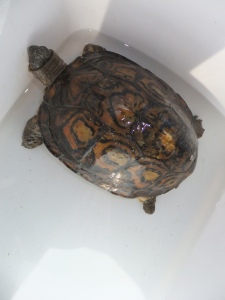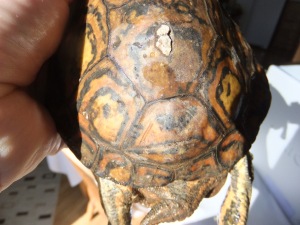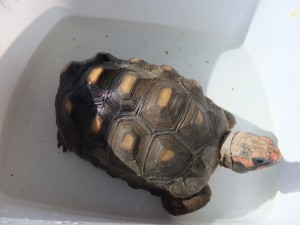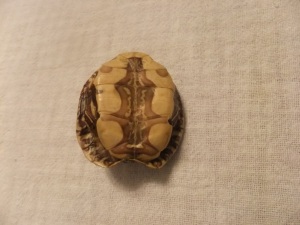Last month I was given a family treasure. Well, in MY mind it is a family treasure.
Here is a little turtle shell that once sat in my Grandmother’s curio cabinet. Way back in the 1960’s I used to look at it and admire it. I wished I had that little turtle shell. I really wished I had the baby turtle.
Where did it come from? What happened to the poor thing? The shell is only two inches long. It’s the shell of a Western Painted Turtle. This little turtle probably hatched one Summer and would have been this size by Autumn. And then…I’ll never know.
My relatives have a cabin along the Wapsipinicon River in Iowa. Very probably this little turtle was born on that river. There are lots of Western Painted Turtles there now.
How’s this for a cosmic thought: His relatives are living there now. Painted Turtles can live 40 years. Maybe one of his brothers or sisters is still there, and right now is lying under the mud, waiting for Spring. I hope so.
I have had a Central American Wood Turtle (Rhinoclemmys pulcherimma) since 1990. That’s almost 23 years! She looked old when I got her. If she was 20 years old when I got her she would be 43 now. Again, I can never know the truth.
But look at this, she is missing a foot!

Her foot was gone when I got her. I’ve always wondered what happened to her foot? I think a predator bit it off!!! These turtles live in Mexico and Central America. Maybe a Jaguar grabbed her!
She also has a big scar on the back end of her shell. A fang mark from the Jaguar!

I bet the Jaguar figured he was going to eat my turtle but No! She turned around and bit him on the nose! The Jaguar screamed and ran off and then… well, maybe I don’t know for sure.
I have also had a Red-foot Tortoise for 3 years. She (you can tell it’s a she by her stubby little tail) has a shell deformity called “pyramiding”. The shell is not evenly rounded but has peaks and valleys.

Her shell looked like this when I got her. As she gets older maybe it will look less
pyramided as she gets a better diet and more sunshine.
There is a ton of information about pyramiding in tortoises. One website says pyramiding is caused by:
too much protein
too little calcium
too much phosphorous (a poor calcium :phosphorous ratio)
not enough D3
However there are some less obvious, though equally important factors involved
lack of exercise
hydration status
grain based diets
lack of fiber
too much food
So my Red-foot probably got the wrong diet, too much protein, when she was young. It’s easy to think they like fruits and worms like our native American Box Turtles but Red-foots like to graze on weeds. They eat a lot of roughage like a cow!



Interesting creatures and I’m amazed at how long lived they can be.
Yes. But most don’t get to live very long. It’s true of most turtles I have kept. It’s sad. I’m trying to take good care of the ones I have now.
My little turtle has shell rot atm. we are trying our best to get it cleared up and we are looking at improving the tank. They are very specific little guys!
I hope you can get him some sunshine. Not through glass but direct rays.
They have a UVB light. We’ve just got them a lovely new filter, we’re looking for a new tank too. He’s got iodine treatment so fingers crossed it will clear up quickly! =^.^=
Some research by the guys at my zoo concluded that humidity is a huge factor in pyramiding. I had a pyramided red-foot, too. I got her that way, and it was so severe that the shell malformation caused her to whistle when she breathed.
Interesting. This tortoise lives outdoors in the Summer. It’s generally very humid but her Winter quarters are much drier. She also “whistles” a little bit as she breathes. I worried about it for a few weeks when I first got her, then realized it was normal for her, but I had no idea why.